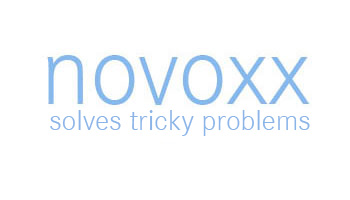FAQ - frequently asked questions
Frequently asked questions and their answers:
What experience has been made with novoxx concerning skin healing?
novoxx supports the healing of wounds with its special mineral substance combination. In a study with leprosy patients who had chronic open wounds 70% of the cases could be treated successfully.
novoxx also supports healing with tattoo colours. The well-known itchiness during healing is described by many users to be reduced considerably compared to conventional colours.
Does novoxx not only avoid the microbial contamination but can it also "equalise" already existing contamination (by unpurified production process)?
The preservative effectiveness of novoxx is based on a physical process which is why it doesn't get used up. Even in the case of intense contamination of the colours novoxx is capable of killing the germs reliably.
However even during colour production one has to work as cleanly as possible because even dead germs can cause infection and allergic reactions.
Can I compare (pros and cons) between using alcohol and novoxx for example? Can I quantify it?
Alcohol only kills germs in defined concentrations. 70% ethyl alcohol offers the best effectiveness. In smaller concentrations (smaller than 18%) this effect is reversed and alcohol acts as culture medium for microorganisms. The smaller the alcohol concentration is, the more microorganisms can survive.
But because alcohol evaporates very easily, even in sealed plastic bottles, the concentration decreases in time and the preservative effect is lost.
In addition to that alcohol has the disadvantage that it stings in wounds, irritates and dries out the skin.
When using novoxx problems like these do not arise. Solely the low cost can be seen as a positive for using alcohol.
Colours based on alcohol should be kept strictly in the refrigerator below 8°C.
How long does novoxx remain active in a container?
novoxx disintegrates very slowly in water, in an applied concentration of 5% the effectiveness will remain for at least 2 years without restrictions. Aging tests indicate that novoxx keeps its effectiveness for a period of 5 years.
In general however a tattoo colour should be used up within 12 months after first opening it as dead germs can cause infections and allergies as well.
Is novoxx UV-resistant or what has to be considered when storing colours containing novoxx?
novoxx is UV-resistant and doesn't call for any specific requirements regarding storage of the colours.
What effect does the anti-oxidative characteristic of novoxx have on the tattoo colour or skin?
Pigments and skin cells are damaged by so-called free radicals. This leads to a quicker aging process.
novoxx is capable of preventing the formatioin of free radicals. Theoretically the durability of the pigments is increased and additionally the skin aging process is counteracted upon.
Can every producer of tattoo colours order novoxx? Which alterations/adaptations regarding the colour description have to be considered?
Basically novoxx is available to all producers whose colours comply with the European Council's resolution "ResAP(2003)2 on tattoos and permanent make-up" .
Contrary to the resolution bottled colours can be supplied.
Tattoo artists who purchase colours with novoxx can therefore assume that these colours contain no illegal ingredients and that the manufacturers' instructions on the label are complete and accurate.
Can even every tattoo artist order novoxx (after purchase of his/her favourite tattoo colour) and add it him-/herself?
No, the smallest container amount is 10kg.
novoxx has to be in the colour from the very beginning and the production process has to be effected under the most absolute hygienic conditions.
This occurs strictly to avoid a transmission of germs in the colours.
We already referred to the danger of dead germs several times before.
Is novoxx already being used in tattoo colours other than at Deep Colours!?
Yes, at the moment the number of producers is small due to the fact that the appropriate formulas have to be re-established and re-tested.
Presently several producers are experimenting with novoxx.
For protection against fraud and imitations all producers and brands who/which officially apply novoxx are publicised on this page.
Clinical tests: How and to what extent have these taken place? What were the results?
The basic material novoxx has been used for more than 30 years as an implant material in surgery and has passed through extensive clinical tests.
These tests have confirmed the extraodinary biocompatibility of the calcium-sodium-phosphor-silicate.
If interested you can get detailed information on the scientific page novoxx.com (in English).
Is novoxx a medical product, cosmetic product or maybe only a household product?
It is a matter of a so-called borderline product. Because of the definition of the medical products law novoxx is not a medical product as its application is not medical.
But novoxx is also not a cosmetic product as it is not used on but under the skin.
What is the anti-microbial effect of novoxx based upon?
The anti-microbial effect of novoxx is based upon the momentary state of science of the enhancement of the ph-value associated with an osmotic pressure on the microorganisms.
In addition there is the "electrostatical charge" of the powder in a watery solution.
The electrostatical charge of the novoxx-particles "attracts" the microorganisms. In the immediate vicinity of the novoxx-particles the ion-concentration is so high that a so-called osmotic pressure occurs on the germs.
In accordance with the high ph-value the organisms are "crushed".
Presently the mechanism is not yet clearly defined but apparently all three factors (ph-value, osmotic pressure and electrostatical charge) have to do with the effectiveness.
novoxx is also defined as bioactive glass. To imagine having glass under the skin is somewhat peculiar. What happens to this glass under the skin?
In physics glass is defined as a non-crystalline solid matter whose atomic structure has a near configuration but not a distant configuration.
This glass should not be confused with the glass we all know, where everyone is reminded of cuts and lacerations.
The finely grounded novoxx powder can best be compared to baby powder and is notably comfortable on the skin.
The word bioactive originates from implant surgery. Bioactive materials are identified as the bodies own and "built-in" to the body as if they were completely natural.
That is how novoxx is built into the cells with the tattoo colour without repelling reactions occurring and it supports the healing of the wounds.
Who developed novoxx?
The base material of novoxx was developed in 1967 by Larry Hench at the University of Florida (UF).
The development of the novoxx powder regarding graining and purification was conducted by a leading glass manufacturer specialist for Deep Colours!. The development for the use in tattoo colours was effected by Deep Colours!




